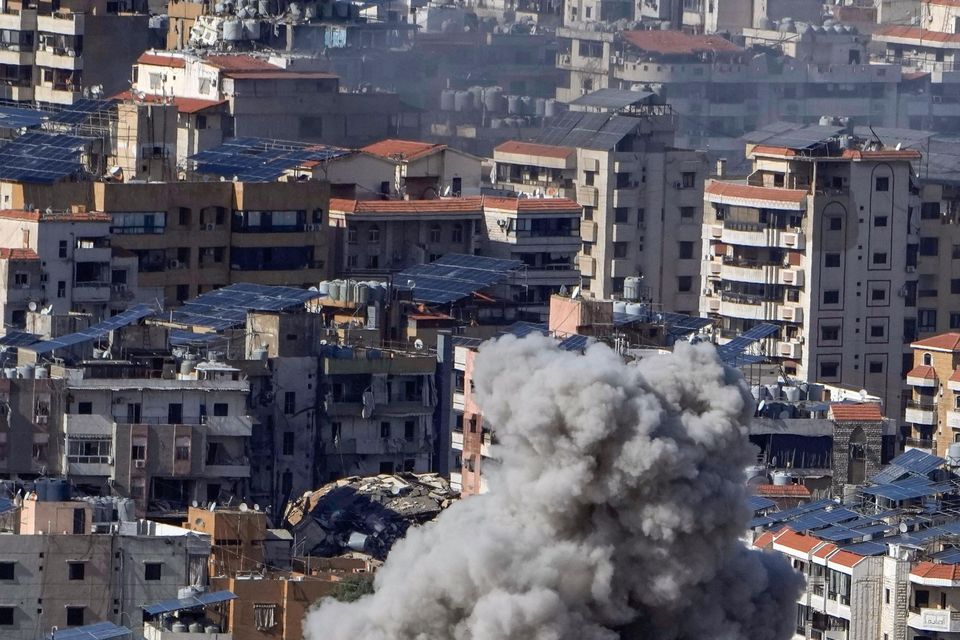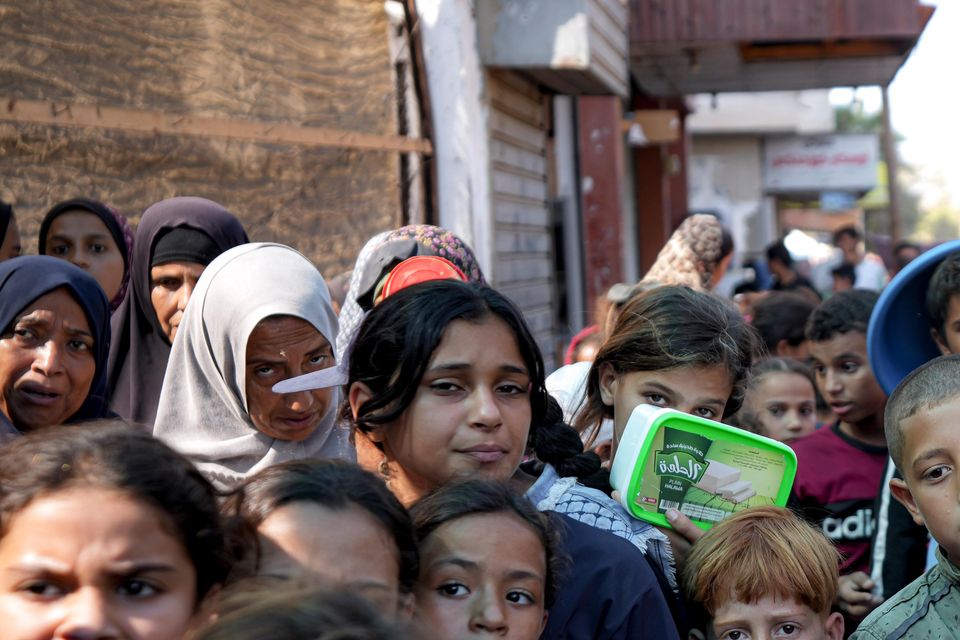Israeli air strikes hit a cafeteria and a home in the Gaza Strip, killing at least 14 people, medical officials said.
Meanwhile, in Lebanon, warplanes struck the southern suburbs of the capital, Beirut, after the military ordered a number of houses there to be evacuated.
The new bombardment on both fronts came on the verge of a deadline set by the United States for Israel to dramatically ramp up humanitarian aid allowed in to Gaza or risk possible restrictions on US military funding.
A group of eight international aid agencies said in a report on Tuesday that Israel has failed to meet the US demands.
In Lebanon, large explosions shook Beirut’s southern suburbs – an area known as Dahiyeh, where Hezbollah has a significant presence – soon after the Israeli military issued evacuation orders for 11 houses there.
There was no immediate word on casualties. The military said the houses contained Hezbollah installations, but the claim could not be independently confirmed.
Smoke rises after an Israeli air strike on Dahiyeh, in the southern suburb of Beirut, Lebanon, on Tuesday (Bilal Hussein/AP)
On Monday night, a strike hit the village of Ain Yaacoub in northern Lebanon, killing at least 16 people, the Lebanese civil defence said.
Four of those killed were Syrian refugees, and another 10 people were injured. There was no immediate Israeli military comment on the strike.
Israel has been carrying out intensified bombardment of Lebanon since late September, vowing to cripple Hezbollah and put a stop to more than year of cross-border fire by the Lebanese militant group on northern Israel.
At the same time, Israel has continued its campaign in the Gaza Strip, now more than 13 months old, triggered by Hamas’s October 7 2023 attack on southern Israel.
An Israeli strike late on Monday hit a makeshift cafeteria used by displaced people in Muwasi, the centre of a “humanitarian zone” that Israel’s military declared earlier in the war.
At least 11 people were killed, including two children, according to officials at Nasser Hospital, where the casualties were taken.
Video from the scene showed men pulling bloodied people from among tables and chairs set up in the sand in an enclosure made of corrugated metal sheets.
Another strike early on Tuesday hit a house in the urban Nuseirat refugee camp in central Gaza, killing three people including a woman, according to the al-Awda Hospital, which received the casualties. The strike injured 11 other people, it said.
The Israeli military had no immediate comment on the strikes.
Hours earlier, the Israeli military announced a small expansion of the humanitarian zone, where it has told Palestinians evacuating from other parts of Gaza to take refuge.
Palestinians gather at the site of an Israeli strike in the courtyard of the Al-Aqsa Hospital where displaced people live in tents, in Deir al-Balah, Gaza Strip, on November 9 (Abdel Kareem Hana/AP)Hundreds of thousands of displaced Palestinians are sheltering in sprawling tent camps in and around Muwasi, a largely desolate area of dunes and agricultural fields with few facilities or services along the Mediterranean coast of southern Gaza.
Israeli forces have also been besieging the northernmost part of Gaza since the beginning of October, battling Hamas fighters it says regrouped there.
With virtually no food or aid allowed in for more than a month, the siege has raised fears of famine among the tens of thousands of Palestinians believed to still be sheltering there.
An October 13 letter signed by US Secretary of State Antony Blinken and Defence Secretary Lloyd Austin gave Israel 30 days to, among other things, allow a minimum of 350 truckloads of goods to enter Gaza each day.
So far, Israel has fallen short. In October, 57 trucks a day entered Gaza on average, and 70 a day in the 10 days of November, according to Israeli figures. The UN puts the number lower, at 37 trucks daily since the beginning of October.
Israel has announced a flurry of measures in recent days to increase aid, including opening a new crossing into central Gaza. But so far the impact is unclear.
The military said on Tuesday that it has allowed hundreds of packages of food and water into Jabaliya and Beit Hanoun, two areas under siege in the far north of Gaza. The Palestinian civil defence agency said three trucks carrying flour, canned food and water have reached Beit Hanoun.
It was only the second delivery allowed into the area since the beginning of October. A smaller cargo was let in last week, though not all of it reached shelters in the north, according to the UN.
Palestinians queue up for food distribution in Deir al-Balah, Gaza Strip, in mid-October (Abdel Kareem Hana/AP)
The military announced on Tuesday that four soldiers had been killed in Jabaliya, taking the number of soldiers killed since the assault there began to 24.
Palestinian health officials say hundreds of Palestinians have been killed, though the true numbers are unknown as rescue workers are unable to reach buildings destroyed in strikes. Israel has ordered residents in the area to evacuate, but the UN has estimated some 70,000 people remain.
Many Palestinians there fear Israel aims to permanently depopulate the area to more easily keep control of it.
On Tuesday, witnesses told the Associated Press that Israeli troops had encircled at least three schools in Beit Hanoun, forcing hundreds of displaced people sheltering inside to leave.
Drones blared announcements demanding people move south to Gaza City, said Mahmoud al-Kafarnah, speaking from one of the schools as sounds of gunfire could be heard. “The tanks are outside,” he said. “We don’t know where to go.”
Hashim Afanah, sheltering with at least 20 other people in his family home, said the forces were evicting people from houses and shelters.
Israel’s campaign in Gaza has killed more than 43,000 Palestinians, according to local health authorities that do not distinguish between civilians and militants in their count but say more than half the dead are women and children.
Israel says it targets Hamas militants and blames the militant group for civilian deaths, saying it operates in residential areas and infrastructure, and among displaced people.
The war in Gaza began when Hamas-led militants stormed into southern Israel on October 7 2023, killed around 1,200 people, mostly civilians, and abducted about 250 as hostages. Around 100 hostages are still inside Gaza, about a third of them believed to be dead.

